Crate Training
Over 90% of dog related issues in the home can be solved by using one simple tool: a crate. This isn’t mean. This is simply setting your dog up to succeed, by not giving them the freedom to fail.
Other than aggression issues, the most common thing we are contacted about is destructive behavior. The first thing we ask is, “is your dog crated?”. More times than not, the answer is a resounding “no!”.
Dogs are denning animals. The only one who is truly upset over this concept, is YOU. Don’t humanize your dog by getting into the mindset that a crate is an evil contraption. A crate could be the one, simple thing that saves you from having to make difficult decisions.
It is completely normal for a dog who has been given
copious amounts of freedom, to buck the system. Just like a entitled
child who has never been given rules and boundaries, they’re going to
look at you like you’re nuts when you try to enforce them. They’re going
to ignore you, roll their eyes and attempt to walk away, and then when
they finally realize that you ain’t playin, they’re going to meltdown
with interjections about “being mean”, “the world is ending”, “this is
stupid” and my favorite, “worst mom ever” complete with slamming doors
and crying. Guess what? They’ll live.

Below are some things you can do to make this change as easy as can be for everyone:
- cover the crate!!! Out of sight, out of mind. We use a sheet. You can use a blanket, or whatever is handy. Throw it over top of them, and get busy doing something else.
- crate them in a common area. No one wants to be put into segregation. This isn’t “Lock-up” even though it may seem that way.
- be confident in your decision. If you’re upset over this, they’re going to manipulate you. Make the decision and follow through. It really is ok.
- don’t shove them in, slam the door and throw away the key. That’s a surefire way to evoke panic. Crates are GOOD things, not bad. You’re making this their “safe space”. So time is essential in working SLOWLY to acclimate them to this change. (See details below)
- crates are NOT, again we repeat, are NOT to be used as punishment. Never, ever use a crate to punish your dogs. Again, think - safe space.
- give them something to do other than pining after you. We use frozen Kong’s, nylabones, antlers. If your dog is a destroyer of all things plush (like some of ours), do NOT put anything in there that they could shred and eat. They do NOT need a bed, contrary to popular opinion. They will be spending only a comparatively short amount of time in there. The plastic won’t kill them. We promise. If they’ve proven to be respectful of bedding, by all means give them something to lay on.
- leaving a TV or radio on while you’re gone is soothing. We recommend smooth jazz.
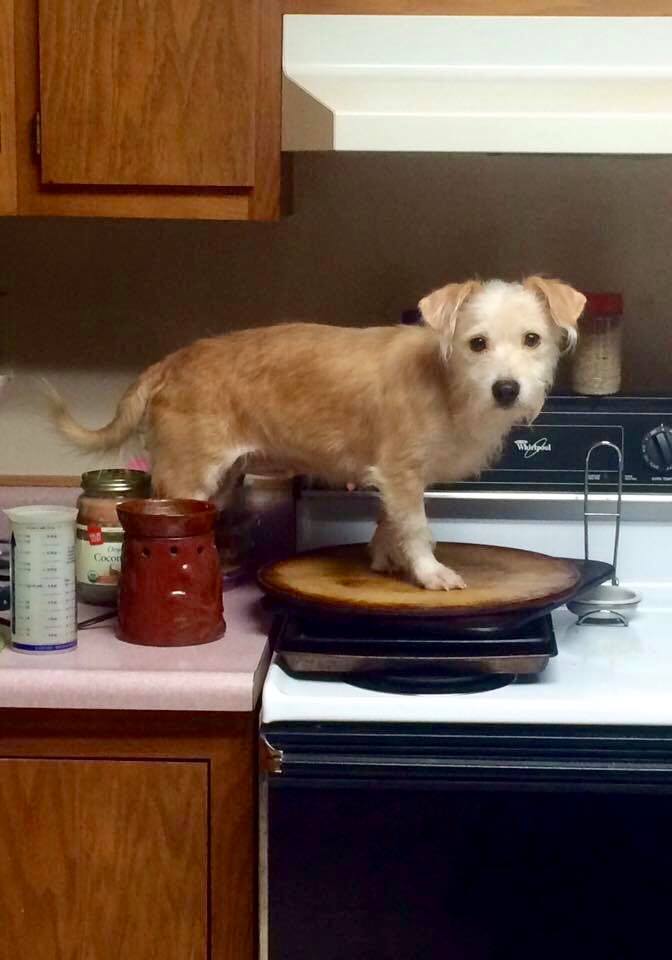
So you may be asking “how the heck do we accomplish turning this death
trap into a place that they actually want to go?” Easy: Patience, time,
follow through and consistency. Keep in mind, we take in dogs weekly
that have NEVER been allowed the opportunity to have any personal space.
This often comes with temper tantrums, but more times than not we are
successful. We are not directing you to do things any differently than
how we do them.
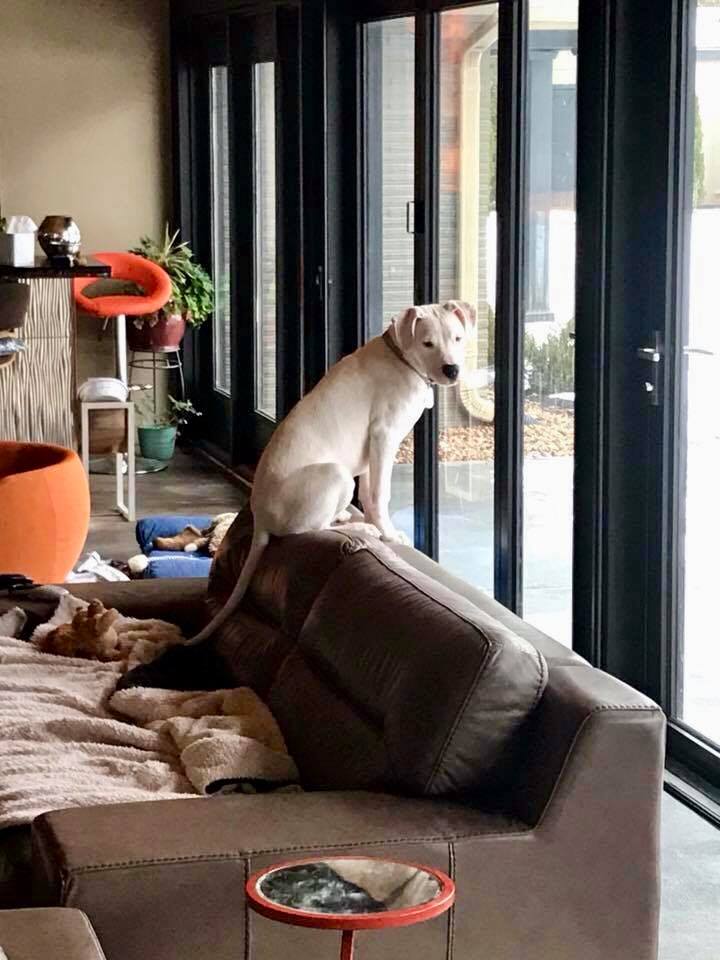
Step 1: Becoming familiar with the crate.
It’s Friday night. You’re home for the weekend. Set the
crate up in a common area, cover it up, open the door and leave it be.
You can periodically toss some high priced items into the back of the
crate to entice them to investigate. Chicken works well, their favorite
toys, peanut butter Kong’s or whatever you have on hand. Some dogs will
even chase a ball into the crate. The goal here is very simple: to go
into the crate on their own. That’s it. THAT IS IT. Really. Step 1 is
that simple. When they go into the crate to inspect, and they WILL, you
mark that behavior as something that you want from them. We use:
“yessss! Good crate” <reward> This is called marking the
behavior, as well as assigning the command “crate” to their action. This
is vital, because eventually their little minds will put together “this
makes Mom happy!”, and they’ll do it again and again. This involves
interaction from you. You’re going to continue this throughout the
evening. Make it a fun game, and a bonding experience. There may even
come a time later in the evening that you actually find them in there
laying down. This is cause to quietly celebrate. Don’t make a big a deal
about it. Let it be.
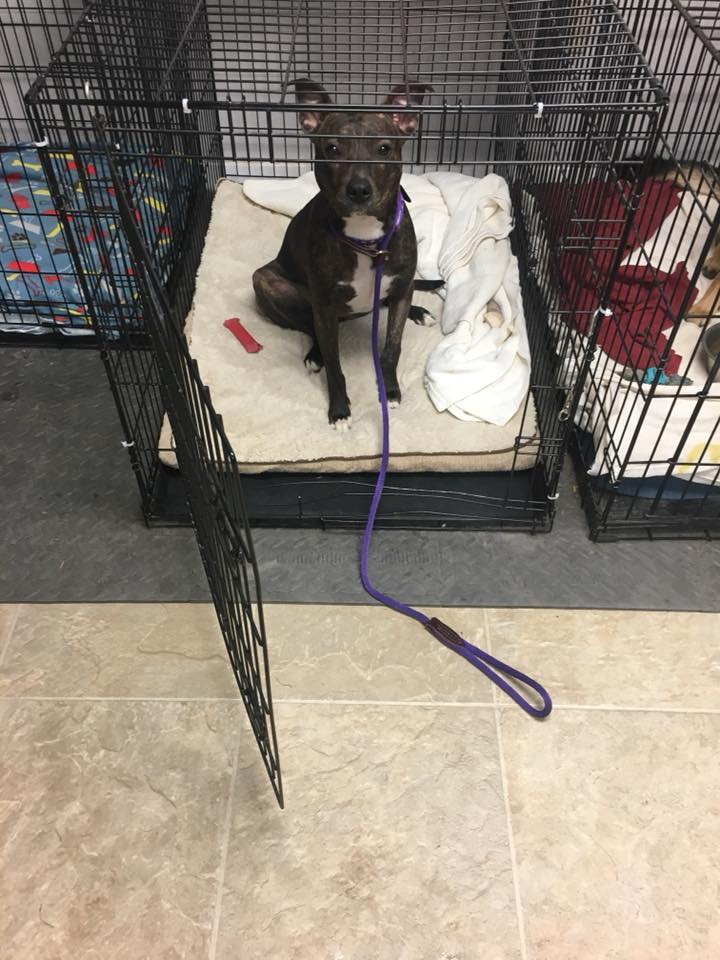
Step 2: Feeding time
Saturday morning. Put a small amount of food in their
bowl, and slide it to the back of the crate. You’re going to encourage
them to actually go into the crate to eat. (NOTE: It’s ok to add
something special to their food to entice them to go in if they’re
hesitant.) When they go in, mark the behavior. HINT: You can separate
their meals into multiple smaller meals throughout the day, to afford
them more opportunities to learn. Remember, these are stepping stones to
creating a safe space. FOR EXAMPLE: If you’re dog eats 2 cups a day,
split those 2 cups into 8 - 1/4 cup feedings, 4 - 1/2 cup feedings or
whatever you so choose. There’s nothing that says they have to eat all
at once. You’re giving them the opportunity to overcome a new challenge.
Repetition and consistency is key.
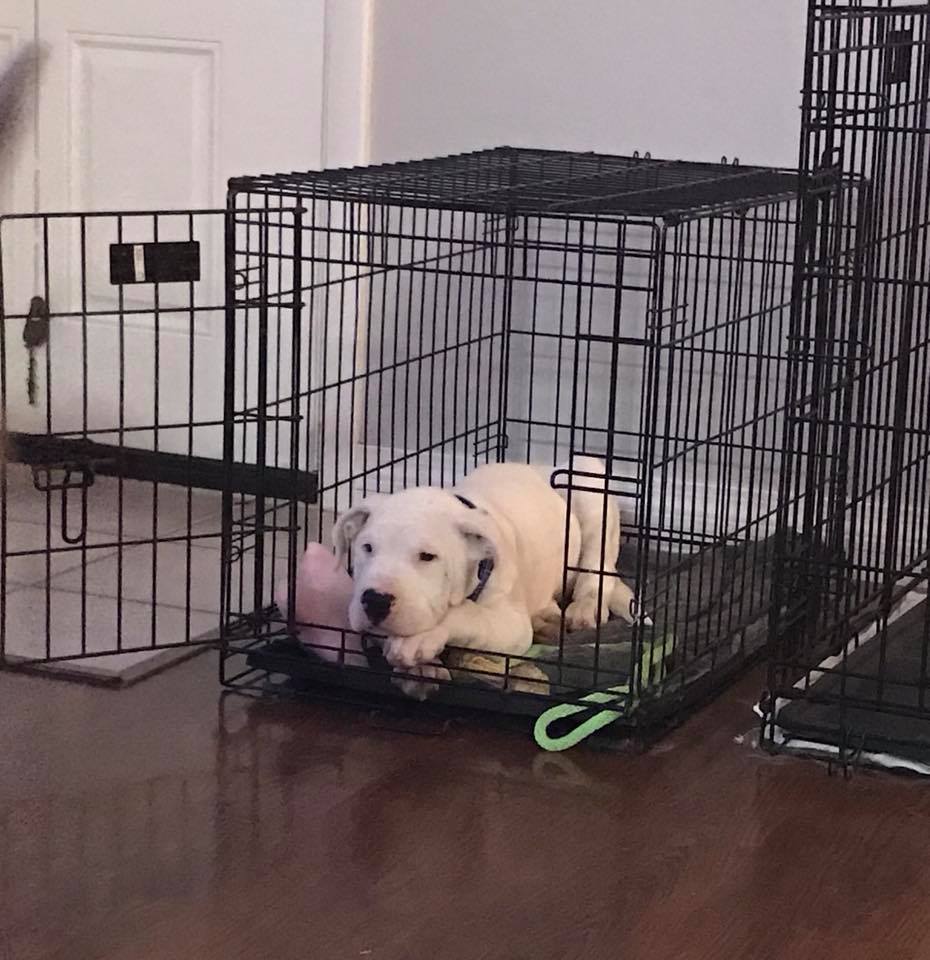
Step 3: Shut the front door!
Saturday afternoon, your dog is now venturing into the
crate periodically on their own, you’re marking the behavior each and
every time they do. You’re now going to close the door when they go in,
but NOT locking it or leaving it shut. Don’t panic. If you get stressed
about this, they will. This is just another fun game. Keep that in mind.
This exercise should look like this (if using their food): slide food
bowl in, give the command, mark the behavior, close the door, wait a
few seconds, open the door, reward. If they don’t panic, and continue to
eat, hold the door shut until they’re done. Then let them out. Reward.
You’re desensitizing them to the action of shutting the door. Throughout
the evening, you’re going to guide them into their crate (remember we
started marking the behavior yesterday. By now they should have an idea
of what “crate” means.). NOTE: We believe it’s ok to use whatever is
needed to entice them into the crate at this point, HOWEVER, if you’re
dog is driven by praise alone, and some are, don’t offer food items here
other than their dinner. We’ll get into this reasoning later. Each time
they go in, mark the behavior, gently hold the door shut, count to 3,
open the door, reward. Repetition is key to being successful. Keep these
training times short and sweet. TIP: It’s important to not push them to
the point of getting irritated (either one of you). We have found 5
mins at a time, to be a good time frame to work them.
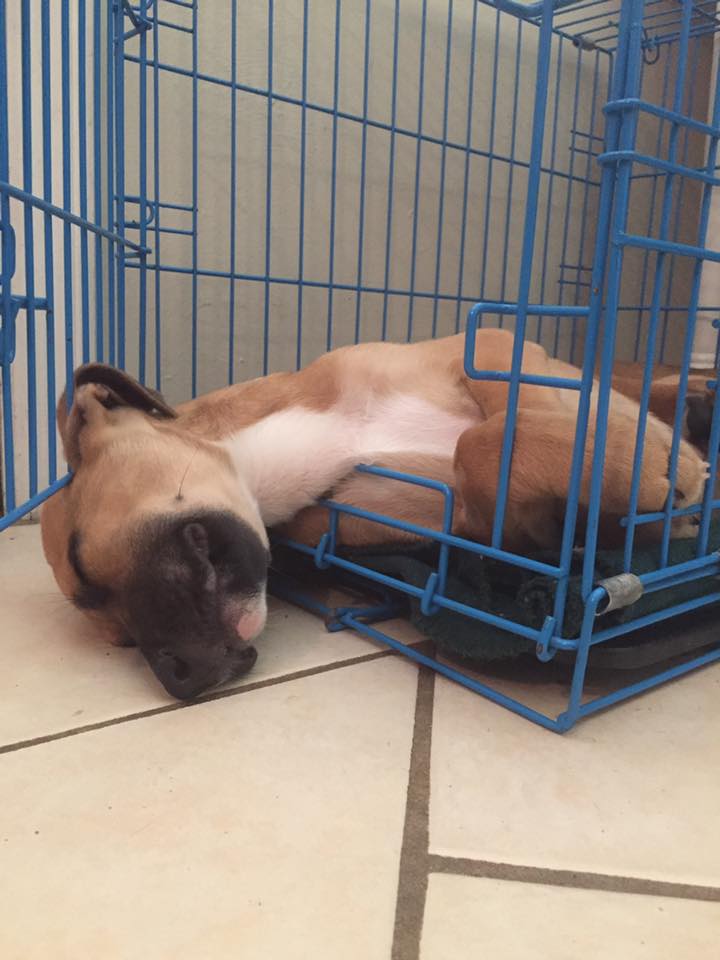
Step 4: Lock and load
Sunday. Locking the door. <cue scary music>
Everything you have done up until now has been a
stepping stone to success. Today we push the boundaries. Some dogs, by
this point, will be over it all, and will surprise you by having a very
high level of compliance. It you’re lucky enough to have a dog like
this, just go with it. For the rest of us who have a slow learner, or
one who likes to test the boundaries - do not give up. The exercise
today will look like this: prepare breakfast, give “crate” command,
slide bowl in, shut and lock door, walk away. It’s important here,
especially if you have a dog who tends to be nervous, to pay attention
to when they’re done eating, and release them immediately. We’re pushing
them past their comfort zone, but NOT causing panic. Remember, safe
space. Throughout the day you’re going to give them small increments of
time to be in their crate with the door shut and locked. Maximum 5 mins
at a time, unless they’re totally ok by this point, and then you can
give them more. You can offer them whatever to keep them occupied during
these short moments in the crate. Whatever you give them STAYS IN THE
CRATE. You’re giving them something to look forward to when they go back
in. So when they try to drag out the peanut butter filled kong when you
open the door, tell them to drop it and throw it back in there and lock
the door. If they show a high level of interest of getting back into
the crate to get the item, open the door, give the “crate” command, shut
the door and walk away. Fold some laundry, do some dishes, run the
vacuum, whatever you need to do. Give them some space and time. TIP:
Always remember to let them out of the crate on a high note. Don’t allow
them to get to the point of panic, or being overly upset, because if
you let them out when they’re in this state, you will have inadvertently
marked that negative behavior. Open the door while they’re in a happy
state of mind. Reward. If they stay in there, you’ve won the battle. If
they don’t, you keep trying.
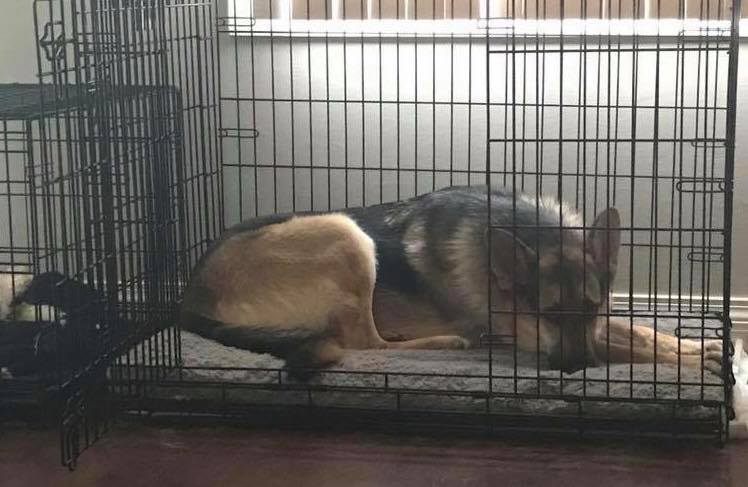
Step 5: A lengthy stay
By Sunday evening you should comfortably be at a place
where your dog is fine with the crate. It’s ok at this point, to up the
time as long as they’re comfortable with it, to a few hours at a time.
Mild protesting is ok. Ignore it. If they get overly worked up, back up a
step. Each dog is different in their tolerance level. Find what works
to keep the stress level at a minimum while pushing them a little. They
won’t learn if they aren’t given the opportunity to fail. A little
whining and/or digging at the crate is normal. For most dogs when they
realize you’re not coming to save them at this point, they will lay
down. Just keep something in there to occupy them when they do comply.
If they calm down, allow them to stay in their crate all night. This
isn’t mean. All of our rescue dogs sleep in their crates. They’re
actually better off for it, as they leave us knowing what to expect.
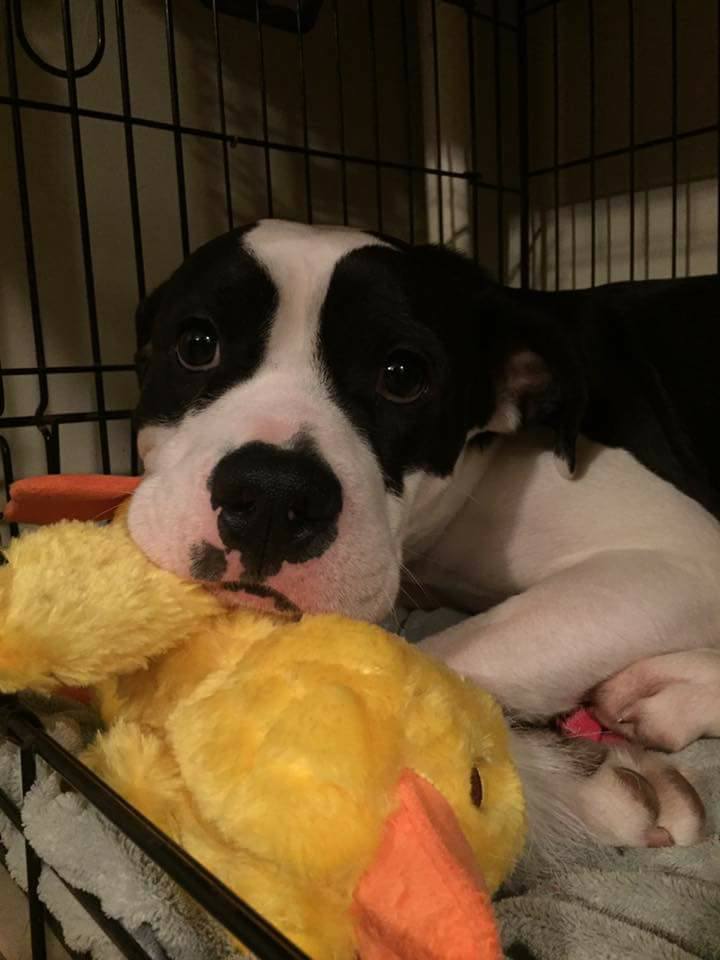
Step 6: The test
By now you will know if your dog is going to calm down in their crate for an extended period. Most do at this point. Go through the same steps from the weekend, except this time when it’s time for you to go, you’re going to walk out the door and try real hard not to focus on how mean you feel. The crate is ok. Leave some music on. Make sure they have something to focus on other than being trapped. If you’re in a position to go home at lunch, we recommend you do so for a week or so. This teaches your dog that you’re coming back to let them out, in a time frame that isn’t any longer than the night before. Consistency is key. They will be less likely to panic when they know there’s an eventual release.
In our experience, a properly, well crate trained dog will go into their crate on their own at any given time during the day. Many of us find our dogs denning with a favorite toy, with the door wide open. This is your goal. When done right, dogs thrive on personal time and space, just like we do. Give them that opportunity.
These steps to crate training are a guideline. All dogs are individuals and will progress on their own time. Please fell free to lessen or extend the time between each step as needed. This is just a guideline.
In the big scheme of things, especially when it comes
down to the prospect of having to re-home your dog over unnecessary,
unwanted, destructive behavior, the crate is the answer. NO ONE should
EVER have to get rid of their dog over something that can be prevented.
Set them up to succeed by not giving them the freedom to fail. It’s that
simple.
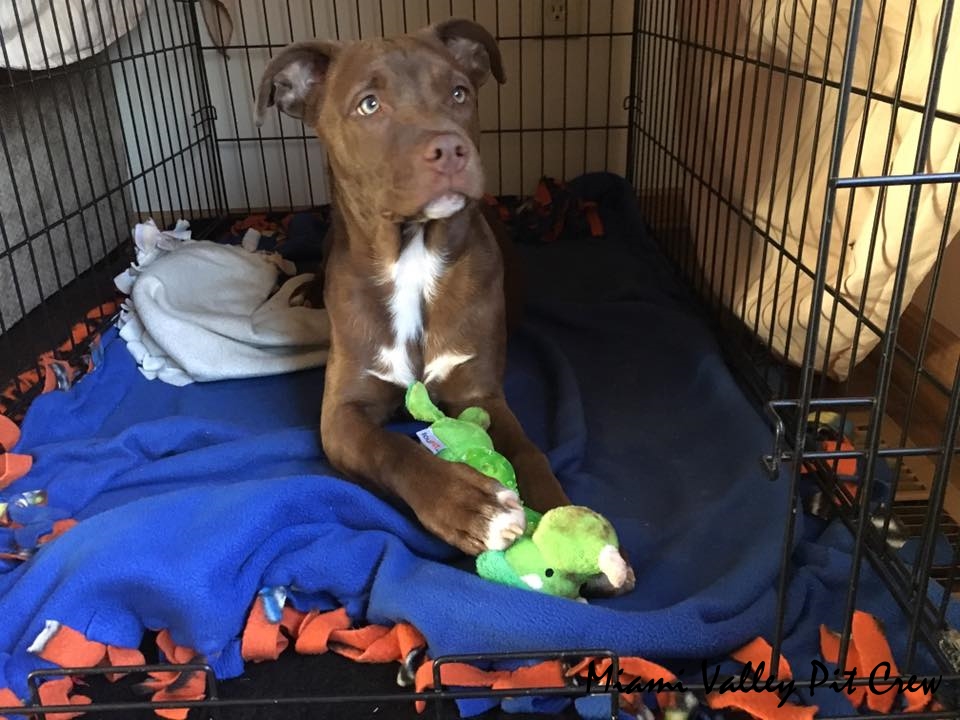
** If your dog is an escape artist, PLEASE email: training4mvpc@gmail.com.
We have a long list of tricks in our arsenal to prevent, or stop this
from happening. There’s no reason to be discouraged or defeated. Just
ask us for help! **

